GoDaddy is a web hosting company that’s sparked controversy and scrutiny since its inception in the late 90s. Not surprising — given the founder’s intentional selection of the business’s name (apparently, Big Daddy was taken). Like when it launched a racy Super Bowl ad in 2005 or was (unintentionally) at the brunt of a lawsuit filed by the film studio of “The Expendables 3.”
Despite this, the web host has continued to attract interest from business owners and individuals wanting to build an online presence.
Let’s take a look at how GoDaddy’s market share is holding up, especially as it’s bombarded with competition in the web hosting industry.
GoDaddy hosting vs. website builder: What’s the difference?
Before we dive into the analysis of their market shares, we need to establish the difference between their two most profitable products. Because GoDaddy is more than a web hosting company. It also offers a website builder similar to Wix. The core differences between the two:
- Website Hosting: provides shared and managed hosting for custom-built and template sites (including those using WordPress themes). Offers automatic updates, backups, security patches, and more.
- Website Builder: allows you to create your own custom site (e.g., store, portfolio, blog) without coding knowledge. Choose from templates, drag-and-drop elements, and add your own content.
Those who already have a website or plan to build one will need a place to host it. This is where GoDaddy’s web hosting service comes in handy. However, if you need to design your website from scratch and don’t want to deal with too many technical details, then the website builder will be useful.
There’s no requirement to use both — you can have one without the other.
What is GoDaddy’s web hosting market share?
Web hosting options have expanded over the years, giving GoDaddy a run for its position as a leader in the industry. According to W3Techs, GoDaddy holds 3.9% of the total web hosting market share and sits in the fourth position, beneath Shopify (4.1%), Newfold Digital (4.5%), and the market leader Amazon (6.2%).
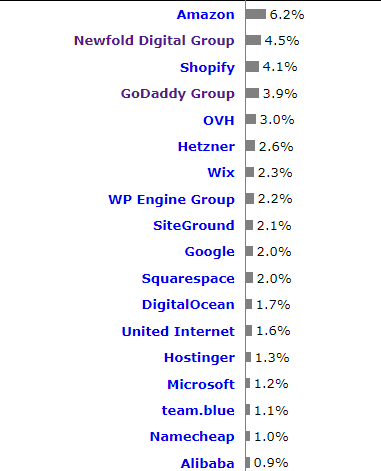
The largest web hosting companies (Source)
GoDaddy usage stats were on the up and up until…
GoDaddy witnessed a steady rise in hosting usage between 2012 and 2019. But when Covid hit, usage rates declined:
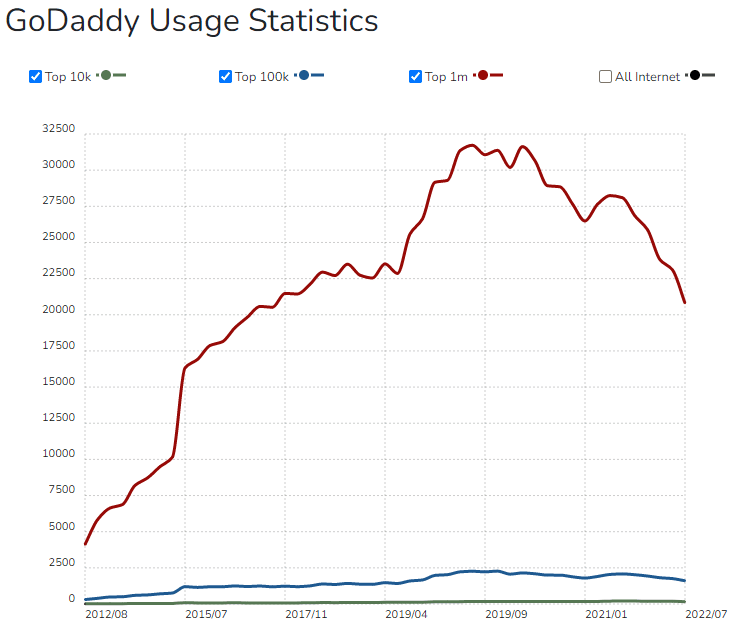
GoDaddy usage statistics (Source)
This isn’t a total shock since many businesses shut down due to illness, daycare issues, or shortages. But it’s hard to pin it down on Covid, since most internet businesses actually did very well because of it.
However, GoDaddy’s position in the market still sits firmly behind Shopify and Amazon, which are leading the charge (especially among ecommerce sellers).

GoDaddy market position (Source)
Under GoDaddy Group (subcategories of hosting and marketing features), the company generates a steady flow of income. In fact, between 2019 and 2021, these products represented 34% and 38% of its total revenue.
Out of all the services it offers, the most popular for website owners is still GoDaddy hosting:
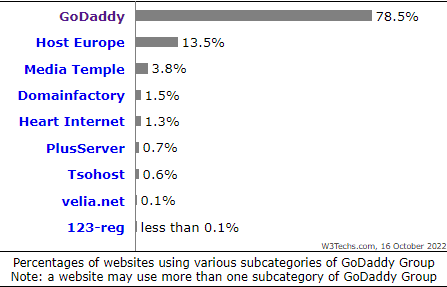
But GoDaddy’s market share still dominates VPS hosting
GoDaddy may not be the “Big Daddy” of the entire web hosting industry, but it sits on the throne for VPS hosting. Here’s a look at its dominance:
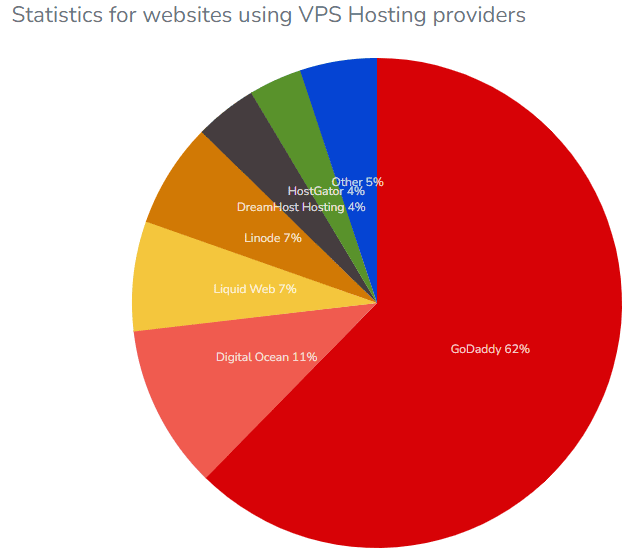
According to BuiltWith, nearly 17 million websites use GoDaddy’s VPS hosting. The closest runner-up doesn’t even come close — Digital Ocean services VPS hosting to under 3 million websites.
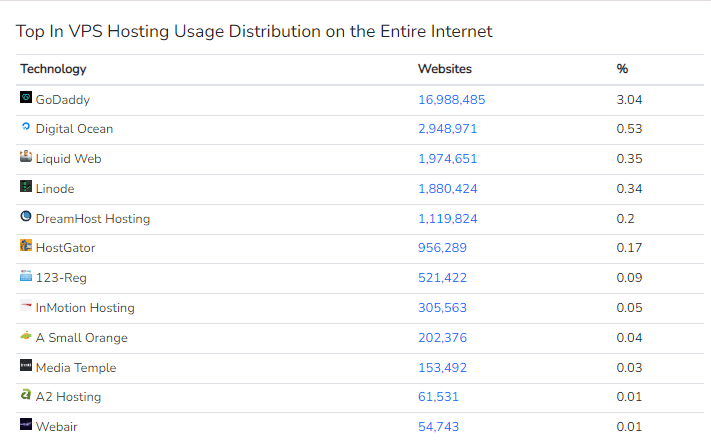
Meanwhile, Wix and Squarespace make web construction easy
Some estimate there are 175 websites built every minute. And today, there are nearly 2 billion sites total. How are people and businesses constructing these sites?
GoDaddy offers a website-building product, but it hasn’t lived up to the “simple” technologies like Wix and Squarespace. These two are dominating forces in website design and development (excluding WordPress), with Wix taking the crown at 45% of sites using its platform to build.
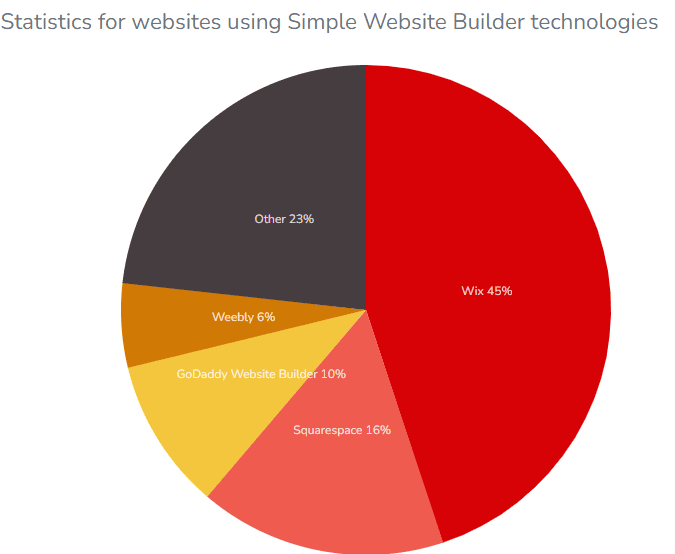
Roughly 8 million websites use Wix’s platform compared to only 1.7 million people using GoDaddy Website Builder:
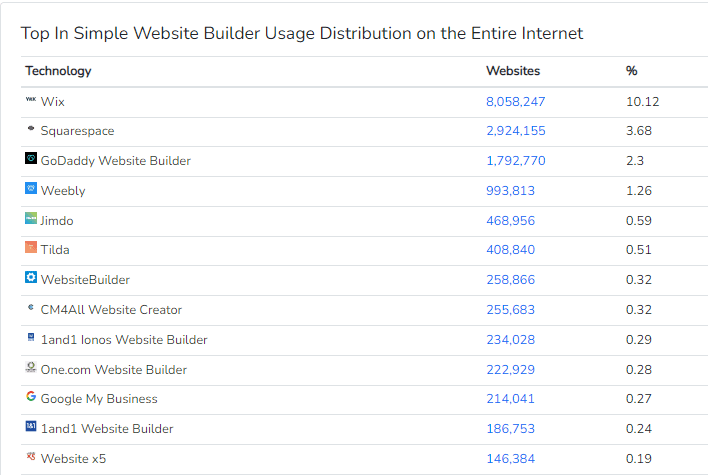
Here’s a look at GoDaddy’s market position on the website building front — when you add advanced website builders like WordPress, Joomla, and Shopify into the mix:
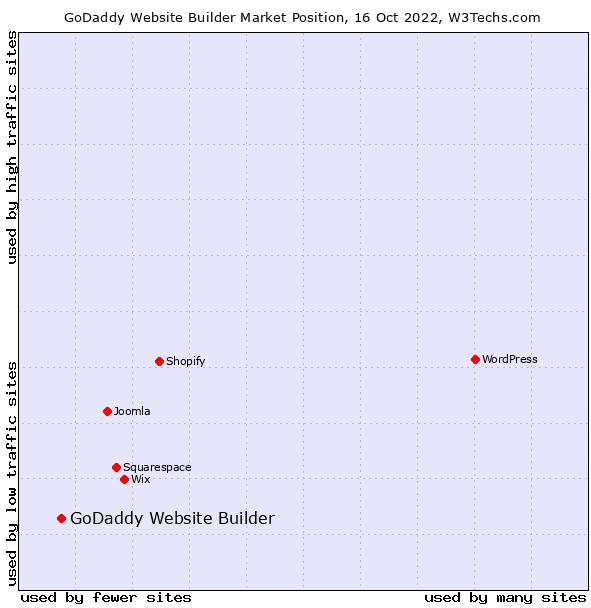
If you can’t beat ’em — venture into other endeavors
One way GoDaddy maintains relevancy is by finding new products and services to introduce to its market. And it does a heck of a job at choosing the right tools to offer to new and existing customers.
Today, it offers additional services, such as:
- Domain registration: allows you to search and receive recommendations for domain names. GoDaddy’s annual report shows that 45% to 47% of its total revenue stemmed from domain product sales (between 2019 and 2021).
- GoDaddy Payments: empowers you to accept payments via GoDaddy Payments, which has a smart POS system for countertop transactions, as well as a mobile card reader and web/desktop software for POS.
- GoDaddy online store (which is part of the website builder): makes building an online store simple for customers starting out in ecommerce or who have little to no programming skills.
- Business applications: offers a suite of features for business professionals, such as @domain.com emails and Microsoft 365 tools (e.g., Teams, Microsoft Office).
- Email and marketing: provides a single dashboard to manage emails, reviews, and social media so businesses can stay in touch with customers.
And it appears to be a success. According to GoDaddy’s 2021 annual report it manages:
- Over 84 million domains
- More than 10 million mailboxes
- 12% of application-built websites
GoDaddy’s email penetration continues to grow, reaching 25% of its customer base (as of 2021). And its marketing and website products also grew by 40% over the past three years.
But as GoDaddy’s product offerings grow, so does its revenue… and its list of competitors.
A look at GoDaddy’s top competitors
Branching into new and emerging markets is a gift and a curse. It introduces your brand to a new field of customers and improves relationships with current customers. But it also opens the door for more competition.
The number of competitors, GoDaddy has increased now that it offers a range of business and website services. Here’s an overview of who they are by industry:
- Domain registration services: Namecheap, Newfold Digital (Bluehost, iPage etc.), United Internet, WP Engine
- Website builder: Shopify, Wix, Squarespace
- Cloud infrastructure services: Comodo, LiquidWeb, Let’s Encrypt, Cloudflare, SiteGround
- Commerce services: PayPal, Stripe, BigCommerce, Square
- Marketing services: Amazon, Meta, Google, TikTok, Toast, MindBody, Yelp, OpenTable
- Productivity tools: Zoho, Microsoft, WeChat, Google, Grasshopper, WhatsApp
When it comes to web hosts, GoDaddy shows resilience in search, which shows people are looking for it more than Wix and almost at the same rate as Shopify:
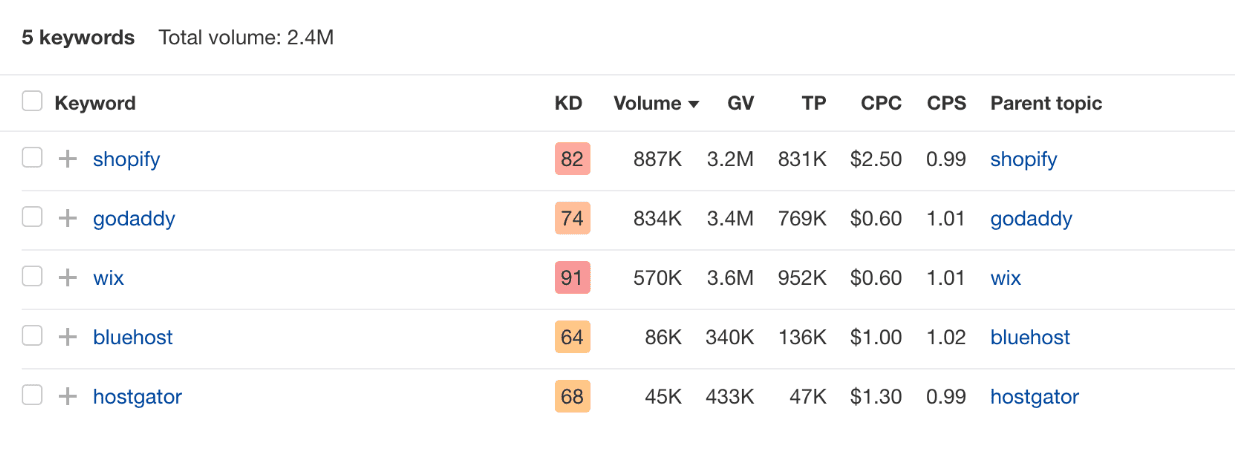
Source: Ahrefs
Yet, in Google Trends, we see GoDaddy struggles to keep up with the two. But hey, at least it’s beating HostGator:
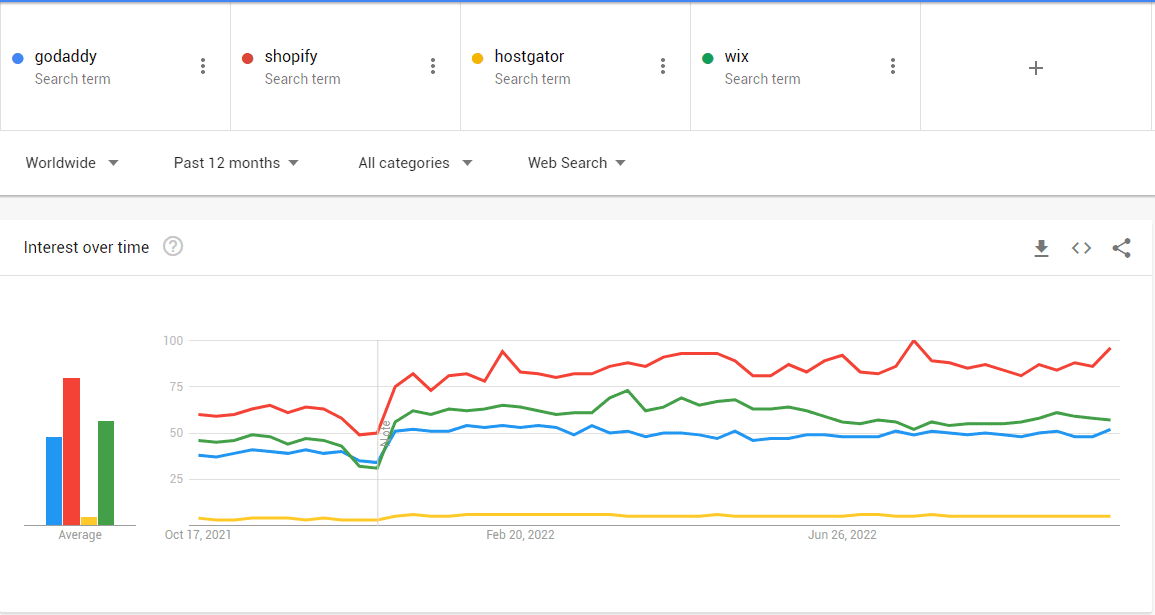
Ventures lead to international borders
GoDaddy wants to be a household name not just in America, but across the seas. And over the years, it’s expanded its operations to various cross-seas countries, including Latin America, Europe, and Asia.
According to the 2021 annual report by GoDaddy, it currently has 55 global sites, and roughly 45% of its customer base and a third of its revenue stems from international accounts. In 2021, international bookings represented 32% of its total bookings.
GoDaddy has its first $1B quarter
GoDaddy’s finances are anything but lacking.
In 2021, GoDaddy reported its first $1B bookings quarter, proving its global and product expansion efforts are working. It was a great first quarter, which saw a 13.8% increase from 2020’s first quarter.
And international revenue accounted for $404M during Q1 2021, a 15.5% increase from Q1 2020.
GoDaddy’s earnings continue to climb
In 2021, GoDaddy generated $3.8B in revenue, a 15% increase from 2020. And $4.2B in total bookings (promised revenue for subscription plans).
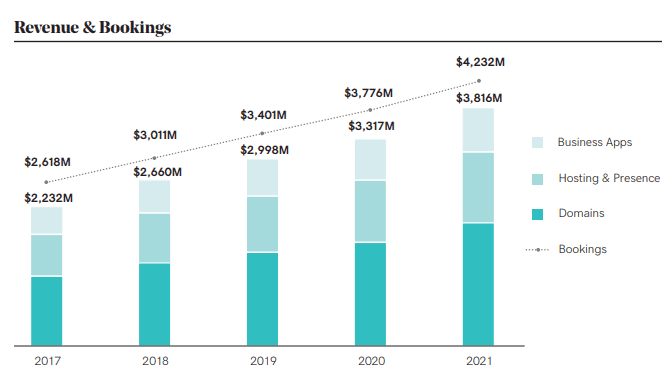
Its customer base is also strong, with over 21M users generating an average of $182 in annual revenue each.
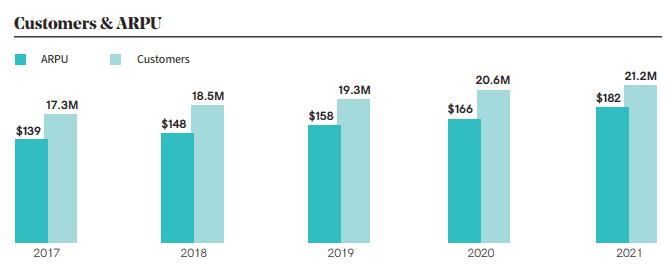
Growth factor 1: GoDaddy’s marketing
So how much of GoDaddy’s success relies on marketing? Possibly a lot, since it spends a large portion of its revenue on spreading word about its services.
It’s one of the reasons it was able to expand into global markets.
According to GoDaddy’s annual report, it spent $1.8B in marketing and advertising over the past five years (ending in Dec. 2021). And it plans to continue investing in branding as it seeks to grow a wider and larger customer base.
Growth factor 2: Acquisitions
But it’s not just marketing that’s attracting customers to its virtual doors. GoDaddy also invests a lot in acquiring businesses that can expand its offerings.
It began in 2012, when it acquired Outright, a cloud-based financial management software. Smart move, since it wanted to target small business owners.
And the trend continued all the way until now. Here’s a look at its most recent strategic acquisitions:
- Over app (Jan 2020): allows entrepreneurs to easily create engaging visual content online
- SkyVerge (Sept 2020): helps entrepreneurs sell online with WordPress and WooCommerce
- Poynt (Dec 2020): expands commerce services with offline sales and integrated payments
- Pagely (Nov 2021): the inventor of managed WordPress, GoDaddy plans to build a world-class WooCommerce SaaS platform that’s reliable, scalable, flexible, secure, and high-performing. WooCommerce is the #1 open-source ecommerce software with 94% of WordPress ecommerce stores built using the platform.
- Dan.com (June 2022): Makes domain trading accessible to everyone. Offers domain investors lease to own options, data science, guidance, and brokerage team.
Target Group: Who are GoDaddy’s dedicated fans?
GoDaddy may not be the top of the web hosting or website building food chain, but it’s eating lavishly anyway — partly due its dedicated users.
In fact, GoDaddy reports its acquisition and retention of customers increased by 85% between 2016 and 2021. And it has a 93% retention rate for customers that have been with them 3+ years.
GoDaddy’s loyal customers consist of three types of customers. Let’s start with the largest:
- Independents: micro-businesses and non-commercial endeavors with fewer than five employees and having little design and tech skills)
- Partners: website designers and developers that work with businesses and non-commercial organizations and have great tech skills, but a desire for flexibility and simplicity)
- Domain registrars (and investors): companies that offer domain registration services to end users (e.g., Amazon Web Services) and also use GoDaddy’s domain registration and management platform.
A look into GoDaddy’s future
GoDaddy proves to be steadfast in not only maintaining its presence as a website host and building platform, but as a tool for online business.
The company plans to continue focusing on expanding into foreign markets, building its brand, and acquiring companies that suit the needs of its customers.
With this strategy, growth is bound to continue.
THE BEHIND THE SCENES OF THIS BLOG
This article has been written and researched following a precise methodology.
Our methodology

